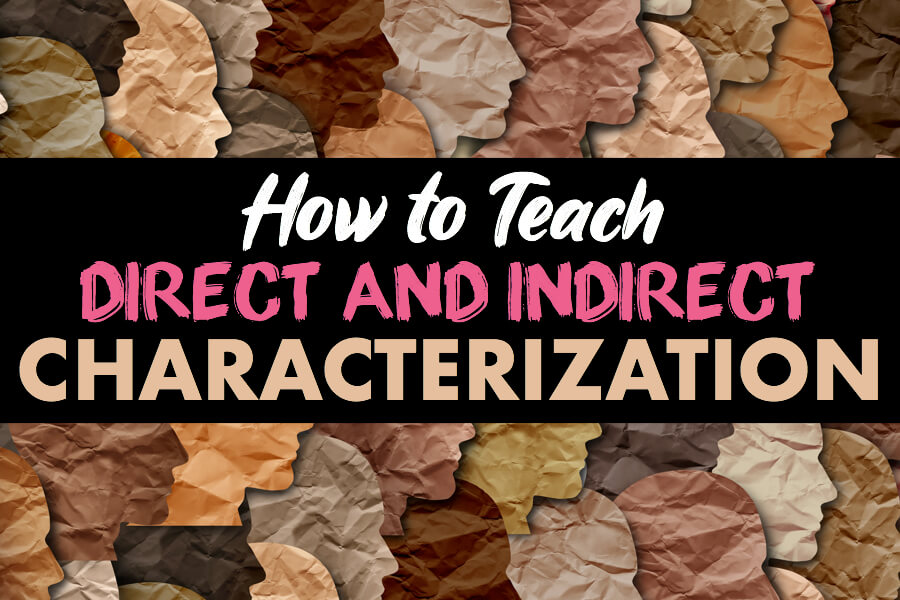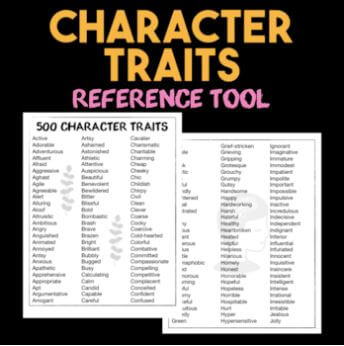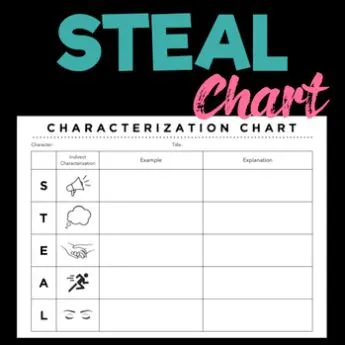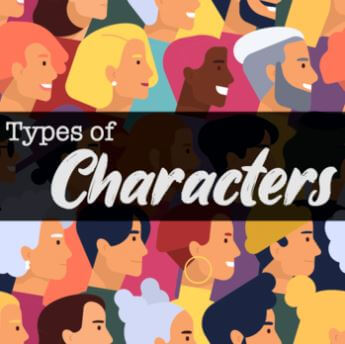Teaching direct and indirect characterization can be a challenge for teachers and students alike. With the right steps and scaffolding in place, it doesn’t have to be. Let this post be your how-to guide for an effective and engaging learning experience.
We all love a good character, right? As teachers, we can understand and appreciate strong characterization. Surely, our students appreciate good characters too, no? Afterall, great characters are a cornerstone of an engaging story for anyone.
However, our students don’t always come to us with a strong understanding of characterization. Sure, they can identify who the characters are. But can they understand and analyze when and how they are developed throughout a story? Especially when it involves reading between the lines and making inferences?
Teaching direct and indirect characterization is a must in the ELA classroom. Luckily, this post is the how-to guide you need for successfully teaching direct and indirect characterization.
The Importance of Teaching Characterization
When we teach our students characterization, we are inherently teaching them to be better readers– and writers! By gaining a stronger understanding of who characters are and how they develop throughout a story, students are able to develop a deeper understanding of the story overall. Afterall, without fully understanding a character, students can get caught up in a one-dimensional view of a character, limiting their comprehension (and appreciation) of a multi-dimensional character, as well as a well-developed plot and theme.
A solid grasp of characterization opens the door for analysis of character decisions, motives, and interactions. Therefore, teaching characterization can enhance students’ overall comprehension of the text. It paves the path for a reading experience that goes beyond surface level. And if that isn’t music to your teaching ears…
Defining Direct and Indirect Characterization: Terms to Know (and Teach!)
Before diving into a text, it’s important to ensure students understand the different ways an author reveals characterization. Therefore, be sure to teach students the difference between direct and indirect characterization.
Generally speaking, when it comes to direct characterization, the author does the leg work. Indirect characterization, on the other hand, requires a bit more work from the reader as they read between the lines in order to draw conclusions about the character.
Direct Characterization
Direct characterization refers to when an author directly reveals things about a character. For example, these direct statements could include anything from what a character looks like to what a character feels. As long as the author is explicitly stating it, it’s direct characterization. There’s no inference or deeper digging needed.
- Example: Susie hated the thunder and lightning. It reminded her of how helpless people were in the face of the powerful forces of nature. With each crack and rumble, she sank deeper and deeper into fear.
Indirect Characterization
On the other hand, indirect characterization is all about reading between the lines and drawing conclusions about a character based on what they do, say, and think, as well as how they interact with other characters. Indirect characterization involves making implicit conclusions based on what is said, thought, or happening in a text.
- Example: As Mateo looked around, he realized everyone else was dressed in slacks with button up shirts neatly tucked in. Looking down at his grass-stained jeans and wrinkled graph T-shirt, his cheeks burned as they turned a shade of bright red.
Why stop there? There are other terms to consider when diving into characterization. Therefore, in addition to direct and indirect characterization, you might consider introducing your students to the ideas of foil, round, flat, dynamic, and static characters.
Laying the Foundation for Teaching Direct And Indirect Characterization
Before introducing any literature, plot, characters, or new terminology, simply start with this warm-up. Have students select any person– real or fictional– that they admire. Have them make a list of that person’s personality traits. Then, have them do the same with a villainous character. (To avoid any drama or awkward situations, I ask them to keep this character fictional. Trust me. You don’t want them describing your “mean” co-worker.)
Give them a few minutes to brainstorm each list. Then, have them select ONE trait for each character. Give them a few more minutes for each to explain an example that PROVES that character trait. For example, if they admire their mom because she’s caring, maybe they write about a time when she took care of them when they were home sick, including all of the little things she did for them.
Alternatively, you can write a positive and negative trait on the board and challenge students to explain why/how a person– real or fictional– fits that description. To amp up the stakes, have students duel it out to find the best fit for each trait. Have every student complete the activity before sharing their responses, trying to find the most [INSERT CHARACTER TRAIT HERE] character in the bunch.
Regardless which way you choose to go about the warm-up, you’ll lay the groundwork for teaching direct and indirect characterization. Of course, you can’t call it a day just yet. But with this context, students will be ready to learn all about characterization in literature.
The Challenge with Indirect Characterization
Due to the explicit nature of direct characterization, students don’t need a ton of work with this concept. However, I can’t say the same for indirect characterization. Due to the critical thought and analysis it requires, students need a bit more help understanding and applying the concept of indirect characterization. The following steps can help:
Introducing the Acronym (TSD) or Mnemonic Device (STEAL)
Acronyms and mnemonic devices are a great way to help students remember what to look for when it comes to characterization.
For younger and struggling students, the acronym TSD is a great starting point for indirect characterization. Explain how a lot is revealed about a character by looking at what they THINK, SAY, and DO.
Alternatively, STEAL is a mnemonic device reminding them to look for examples of the following:
- SAYS: What does the character say? How do they say it? What does it reveal about them?
- THINKS: What does the character’s thoughts reveal about them that we might not otherwise know?
- EFFECT: What effect does the character have on others? How do they interact with other characters?
- ACTS: What is the character doing? What do their behaviors reveal about them?
- LOOKS: What conclusions can you draw based on how the character looks? What does their physical appearance reveal?
Focus on Finding Evidence
One of our goals as teachers at the secondary level is to encourage students to support their thoughts and conclusions with explicit evidence from the text. At this point, students should be moving on from simply making observations and onto reading between the lines to draw implicit conclusions. Therefore, they must work on explaining their thought process behind their inferences.
When first teaching indirect characterization, consider shifting the focus from character traits to finding evidence. Why? This approach will help students find their evidence first, and then work backwards to determine what the evidence reveals about said character. Otherwise, you risk students mindlessly skimming the pages as they complain they “can’t find any examples.”
So, while many people are used to teaching students to find examples of a certain character trait, consider switching it around and letting students create their own conclusions about a character as they read.
Encourage Success with Scaffolding
Questions, graphic organizers, and thinking stems, oh my!
Those are three of my favorite ways to scaffold characterization, especially when it comes to indirect characterization.
Guide students through characterization by having them answer questions as they read:
- How would you describe [CHARACTER]? Why?
- Why do you think [CHARACTER] acted that way?
- What conclusions can you draw based on their appearance?
- What do you think [CHARACTER] said [INSERT QUOTE]?
- How might the story change if [CHARACTER] was/did [TRAIT/ACTION] instead of [TRAIT/ACTION]?
Additionally, graphic organizers are the perfect scaffolding tool for literary analysis, including characterization. It’s a useful tool in guiding students through a multi-step thought process such as cause and effect. The highly organized and visual nature of graphic organizers helps even those that struggle with comprehension to find success.
Similarly, thinking stems help students get in the right frame of mind to analyze various examples of characterization, such as thoughts, speech, or actions. Scaffolding in this way gives students a frame of reference while still requiring them to do the heavy lifting. Consider the following thinking stems:
- When [CHARACTER] thinks … it reveals …
- When [CHARACTER] says … it reveals …
- When [CHARACTER] does … it reveals …
Advance to Writing Well-Developed Responses
The next step is to translate a graphic organizer or thinking stems into a more thorough response. As you move students from one phase to the next, consider the following steps to writing a well-developed paragraph for character analysis.
Students must first choose an example of indirect characterization, determining which character trait it reveals. Have them begin with one to two sentences summarizing the situation to provide context. Next up? Introduce the telling piece of textual evidence and include the direct quote. Finally, encourage students to expand upon their explanation/analysis of the indirect characterization. How does this example reveal said trait about the character? This might include connecting it back to a main idea, theme, or thesis of the literature or essay.
Have your students do this three times over and BAM! You have the body of a five paragraph character analysis essay.
Assessing Direct and Indirect Characterization
There are a lot of ways you can assess your students’ understanding of direct and indirect characterization. Could you have them write a traditional essay? Sure. But, don’t think that is your only option.
Consider these more creative (and fun) approaches to assessing students’ understanding of these characterization concepts:
- Create a character playlist. What songs would be on there and why? How does each song represent the character?
- Design a character social media profile. I’ve had success with student’s creating Twitter, Instagram, and Facebook profiles for characters.
- Write a character diary. What would the entries be about? How would the character write about certain events and/or relationships?
- Transcribe an interview with the character. What questions would you ask and how would they respond?
- Make a character collage. What elements would you include and why? This is a great way to encourage literal and abstract (direct and indirect) thought.
- Build a character resume. What job would the character apply for? What skills and experience would they include?
Regardless of which activity you choose, the result is the same: A holistic character analysis that includes both direct and indirect characterization!
Teaching Characterization Beyond Character Traits
The beauty of teaching direct and indirect characterization is the ability to expand students’ understanding of what characterization is. Many students stick to the basics of character traits. They could come up with a mile-long list of adjectives describing a particular character.
However, you can use direct and indirect characterization to dig even deeper. To encourage students to consider the why behind those character traits. Challenge students to draw conclusions about character changes, relationships, and motivation. Character tracking is a great way for students to notice characterization over the course of a story.
Ready to get started?
Hopefully you found a few useful tips to bring into your classroom for when you dive into the world of characterization. As for which texts are best to use when teaching direct and indirect characterization, the world of literature is your oyster. You can use excerpts, short stories, or novels. Hey, you can even use video clips, tv shows, and movies if you wish to mix it up! As long as there is good character development, it will work.
Happy teaching, my friend!



